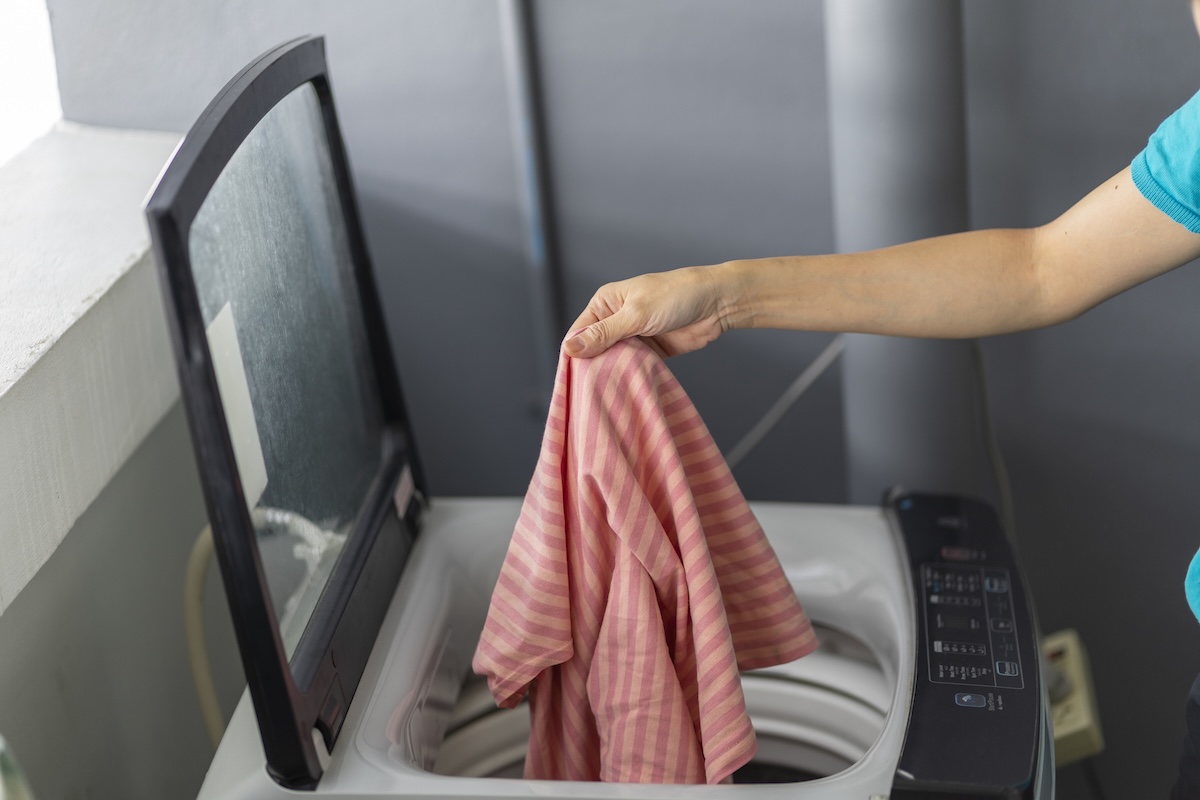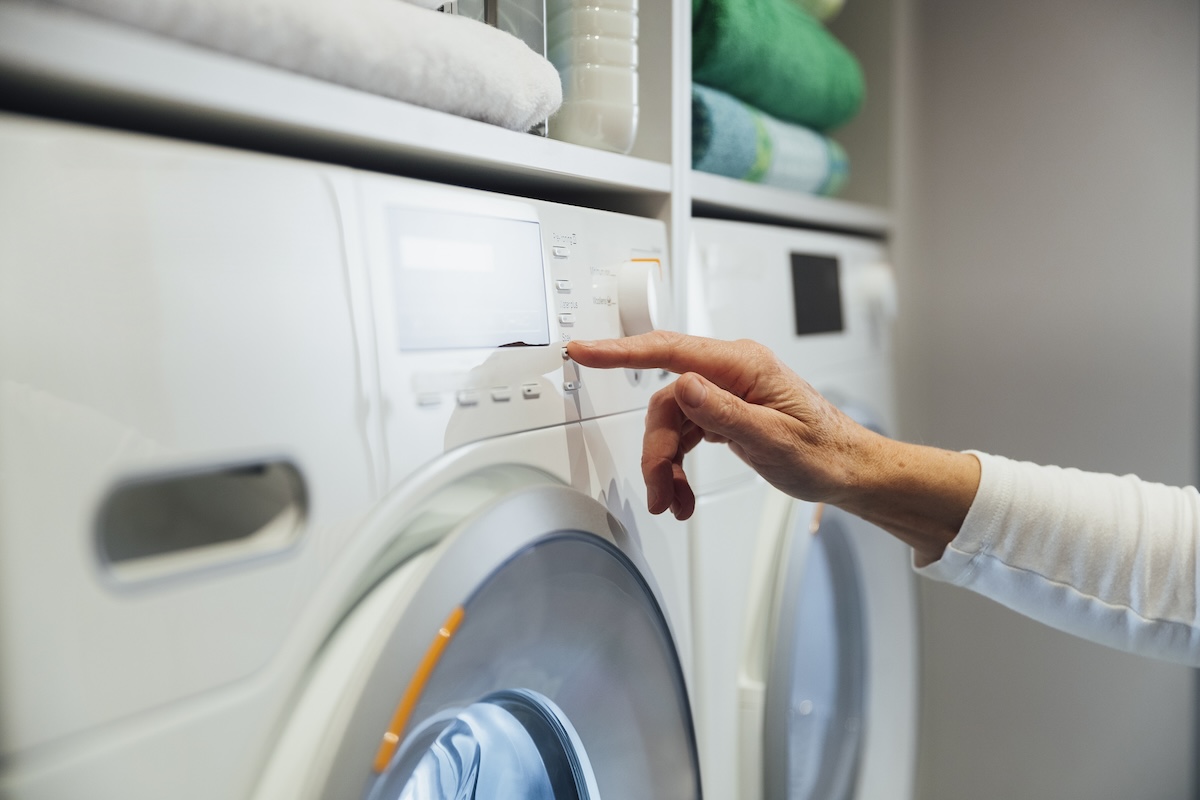

We may earn revenue from the products available on this page and participate in affiliate programs. Learn More ›
What You Need to Know
- Some reasons for a washer not filling with water include issues with the lid switch, a kinked hose, clogs, damaged switches, and malfunctioning electronic controls or timers.
- It’s wise to let an appliance repair professional handle washer issues to avoid damaging the machine further.
- A home warranty can provide coverage for appliance repairs, including washing machines.
If you have a washer that’s not filling with water, laundry day can quickly turn frustrating. Fortunately, this common issue is often easy to troubleshoot yourself. Problems can range from simple fixes, like checking for kinked hoses or clogged inlet screens, to more serious mechanical or electronic issues that may require professional assistance.
Reasons for Washing Machine Water Not Filling Up

These simple DIY troubleshooting steps can help you get your washer filling with water again. We’ll also explain when it might be time to call in a professional appliance technician.
1. The lid isn’t closed properly.
If your top-loading washer’s lid isn’t securely closed, the machine typically won’t run. First, double-check that you’ve fully closed the lid.
If the lid is definitely closed, the issue could be the lid switch (a safety feature that prevents the washer from running when the lid is open). If the lid switch malfunctions, it won’t signal the washer to fill with water. Check whether the lid switch can be activated manually, and make sure its levers aren’t stuck or broken. Sometimes, simply repositioning or manually activating the switch will resolve the problem. Fortunately, if the switch needs replacing, it’s usually a quick and inexpensive fix for a professional appliance technician.
2. The hot and cold water supplies aren’t on.
If your lid and lid switch seem fine, the next step is to check the hot and cold water supply valves, usually located directly behind your washing machine near the lower part of the back panel. The cold water valve typically has a blue knob, while the hot water valve usually has a red knob.
Make sure both knobs are fully turned to the “on” position. If they’re already open, check the hoses connected to these valves for any kinks that might be blocking the water flow. Straightening out any visible kinks and repositioning the hoses can often resolve the issue. After adjusting, test the washer again to see if water flows properly.
3. The water inlet screens are clogged.
If the hot and cold water hoses are turned on and are free from any kinks, the next step is to check the inlet screens. The inlet screen is responsible for catching debris, and it could be clogged, preventing water from flowing into the washing machine.
The good news is that this is a simple fix requiring zero tools, just a little time and elbow grease. If the inlet screen is clogged, and that’s why water is not filling the washing machine, the user will first need to turn off the water to the unit and disconnect the hoses from the washer. Then they’ll be able to see the filter screen and remove any particles blocking the flow of water. After cleaning the screen, the hoses can be reattached and the water turned back on.
4. There’s an issue with the selector switch or water level switch.
When water is not going into the washer, the problem could result from a faulty selector switch or water level switch. If the user can choose the temperature of the water for wash and rinse cycles, the selector switch is what tells the water inlet valve to open the hot and cold inlets and fill the machine. It’s possible to test if this switch is damaged or worn down by unplugging the washer and using its wiring schematic to test the terminals with a multimeter.
Similarly, newer models of washing machines have a sensor that tells them when the water gets to a certain level and forces the machine to stop filling. If the water level switch isn’t working, it could be wrongly telling the machine that the water is at too high a level to fill, even if no water is in the unit.
Both of these issues will require the help of an appliance repair specialist who can inspect the machine and bring the necessary parts and tools to repair it.
5. The timer or electronic controls are malfunctioning.
If the steps above didn’t resolve the issue, there may be a malfunction with the washer’s timer or electronic controls. Because troubleshooting these components involves working with live voltage, it’s safest to call a professional appliance repair technician to handle this type of problem.
The timer and electronic controls send signals to the water inlet valve, prompting it to open and fill the washer. Specifically, electrical contacts operated by a cam assembly—powered by the timer motor—control this process. If any of these elements malfunction, your washer won’t receive the proper signals needed to fill with water.
A trained technician can safely diagnose issues with these parts, typically using a wiring schematic and a multimeter to test the timer’s terminals for continuity. Since this involves electrical expertise and the risk of electric shock, it’s best left to professionals.
6. There’s a problem with the water flow.
If your washing machine still isn’t filling with water, there could be an issue with the home’s water pressure or flow. First, verify that water flows normally from other faucets in your home. If not, you might have a broader plumbing issue requiring a plumber. That said, if water flow elsewhere seems fine, check the inlet hoses for internal obstructions or sediment buildup. Removing and cleaning (or replacing) these hoses can often restore proper water flow.
7. There are broken or damaged wires.
Your washer relies on electrical wiring to operate valves, timers, and switches. If wires become frayed, disconnected, or damaged, the signals needed to fill the washer might not be sent properly. Check the visible wiring carefully (always unplug the washer first) for obvious signs of wear or breaks. If you suspect damaged wiring, call a professional appliance technician. Fixing electrical wiring is not a DIY project due to safety risks.
When to Call a Professional for Washing Machine Repair

Many washing machine issues are simple enough for homeowners to troubleshoot themselves, but certain problems should be handled by a professional appliance repair technician. Here are some clear signs it’s time to call in a pro:
- Electrical issues: If your washer shows signs of damaged wiring, malfunctioning electronic controls, or timers, professional expertise is essential to avoid electrical hazards.
- Internal component repairs: Problems with the pressure switch, water inlet valve replacements, or internal mechanical components require specialized tools and training.
- Persistent or unclear issues: If you’ve tried basic troubleshooting steps and your washer still isn’t filling, a technician can accurately diagnose and repair the underlying problem.
Hiring a professional not only ensures safety but also provides peace of mind, as their repairs are often backed by warranty coverage.It might also be worthwhile to look into getting a policy from one of the best home warranty companies (such as American Home Shield or AFC Home Club). A policy can help alleviate the high cost of appliance repairs in the long term.
FAQs
Your top-load washer might not fill with water due to common issues like a faulty lid switch, kinked hoses, closed water valves, clogged inlet screens, or more serious electrical problems involving timers and switches. Simple checks can solve some of these problems, but others require a professional technician.
If your washing machine is humming but not filling, it’s often due to a faulty or clogged water inlet valve. The valve may be electrically active (humming) but unable to open fully to allow water flow. Checking for clogs or replacing the valve usually resolves the issue.
To check if it’s a water supply issue, test other faucets around your home to make sure that water flows normally. If other taps have good pressure, the issue likely lies with your washing machine. Low water pressure everywhere points toward a home plumbing issue.
Washing machines typically last around 10 to 13 years. If your washer frequently requires repairs, leaks significantly, or has reached this age range, it might be time to replace it.
